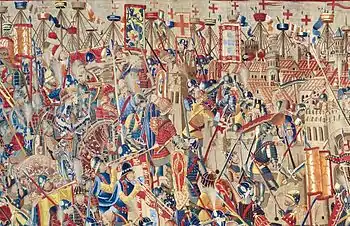| Conquest of Asilah | |||||||
|---|---|---|---|---|---|---|---|
| Part of Moroccan-Portuguese conflicts | |||||||
 The Portuguese assault on Asilah depicted on a 15th century tapestry. | |||||||
| |||||||
| Belligerents | |||||||
| Kingdom of Portugal | Wattasid Morocco | ||||||
| Commanders and leaders | |||||||
|
Afonso V of Portugal Prince John | Mohamed Cheikh | ||||||
| Strength | |||||||
|
30,000 men 400 ships | Unknown | ||||||
| Casualties and losses | |||||||
| Unknown |
2,000 killed[1] 5,000 captured[1] | ||||||
The Portuguese conquest of Asilah (Arabic: أصيلة، أرزيلة; Portuguese: Arzila) in modern Morocco from the Wattasids took place on 24 August 1471.
History
Continuing with his policy of expansion of the Portuguese territories in Morocco, and with the spirit of Crusade against the Muslims always present, King Afonso V of Portugal initially set plans to conquer Tangier, but subsequently decided to conquer Arzila.
Departing from the Portuguese town of Lagos with an army of about 30,000 men and 400 ships,[2] Afonso V arrived at the Moroccan coast on the afternoon of 22 August 1471. The Portuguese King summoned his Council and decided to attack Asilah on the morning of the following day. There was a terrible storm and a number of Portuguese ships were lost. It poured rain the entire three days of the siege.[3]
The storm was so severe it prevented the ships from laying down a cannon bombardment, and only two pieces of heavy artillery were brought to shore. After a troubled disembarkation that resulted in the death of more than 200 men caused by strong winds and waves, Afonso's army reached the shore and laid siege to the city of Asilah, conquering it after a hard battle on 24 of August, 1471.[1]
The Count of Valença, Henrique de Menezes, was appointed as the first Portuguese governor of Asilah by King Afonso V.[4]
The victory at Asilah paved the way for the unopposed conquest of Tangier four days later on 28 August 1471.[3]
Pastrana Tapestries
In the late 15th century, a set of four large tapestries was commissioned to commemorate the battle. They were woven by Flemish weavers in Tournai, Belgium. The tapestries are notable highly for their portrayal of a contemporary event. The works are regarded as among the finest Gothic tapestries in existence.[3]
Notes
- 1 2 3 Diffie, Shafer, Winius "On August 24 the Portuguese captured the city killing some 2000 "infidels" and taking 5000 captives." p.145
- ↑ Black, "Asilah had been captured in 1471 by a Portuguese force of 400 ships and 30,000 men." p.18
- 1 2 3 ""The Invention of Glory: Afonso V and the Pastrana Tapestries", National Gallery of Art" (PDF). Archived from the original (PDF) on 2016-12-21. Retrieved 2014-07-30.
- ↑ Quintella, p.181, p.182
References
- Jeremy Black, Cambridge illustrated atlas, warfare: Renaissance to revolution, 1492-1792 (1996) ISBN 0-521-47033-1
- Bailey Wallys Diffie,Boyd C. Shafer,George Davison Winius, Foundations of the Portuguese empire, 1415-1580 (1977) ISBN 0-8166-0782-6
- Ignacio da Costa Quintella, Academia das Ciências de Lisboa, Annaes da marinha portugueza, Volume 1 (1839)